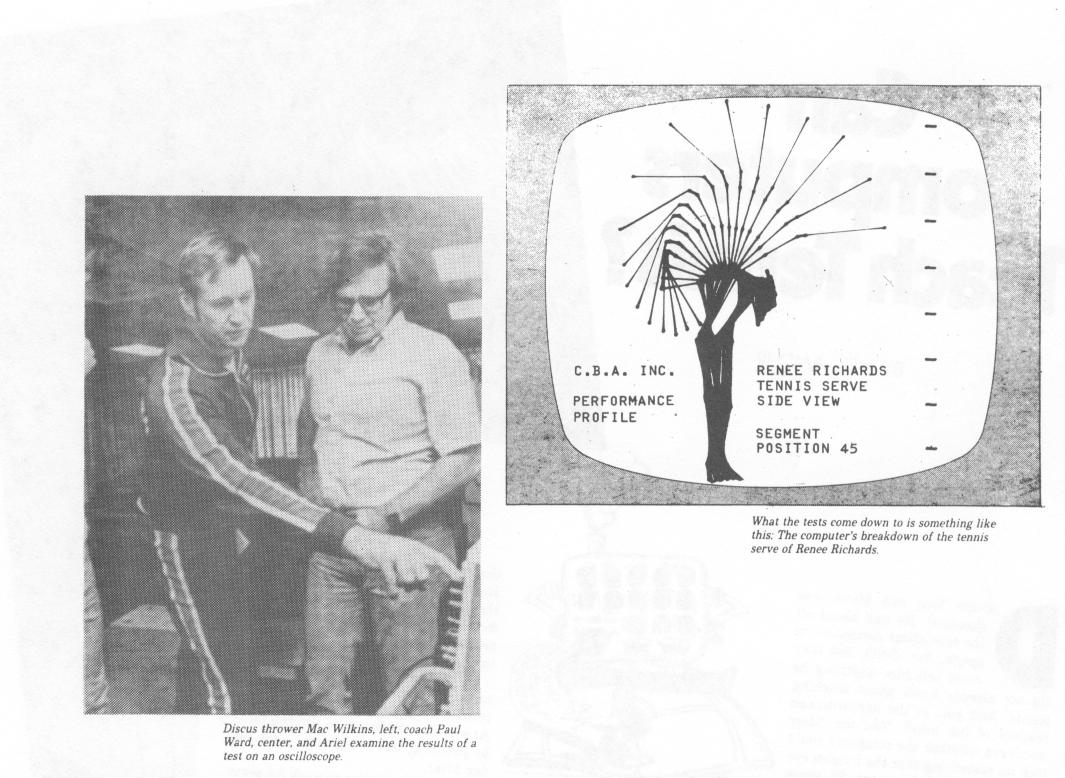| Previous | Index |
![]()
red at the School of Exercise Science at UMass. for his masters degree.
There he came up with the digitizer, a screen lined with 20,000 tiny microphones that, when touched with a sonic pen registers the information in a "omputer.
In 1968, he rented Dartmouth's timesharing computer and, in 1971, he founded CBA. With contracts from Spalding and Uniroyal to test equipment, Arid made enough money to buy his own computers. In 1972, he received his PhD in exercise science, and the rest is histrionic
"I am only responsible to myself, arid that is good," Ariei says, "but this country stops progress. Every time I have a new idea, I get hit with a lawsuit. There were soon too many to respond to in writing, so now I have those on the computer, too."
Ariel, a man with infectious energy and a sharp accent even though he has been here 14 years, has ideas about all sports, most of which he does not play.
On golf: "People think what makes a good swing is the follow-through. That means nothing. It's the energy released before the club hits the ball. The followthrough is only the energy left in the club."
On tennis: "The follow-through there,
too, is a waste. When Bjorn Borg turns his racket over, it is only for show. The ball is long gone. The bait is on the racquet only four milliseconds. The difference between a good backhand and a bad one is three degrees. Racquets of the future will he wooden. Who sivs you need strings? The wood will be anted so if you miss in that three degrees, you will still have a
On kayaking: "In the United States, the athletes accelerate at the beginning of the stroke. They should accelerate at the end, like the Europeans. It keeps the tip of the bow down in the water."
On jogging shoes: "Too much shock. People will wear inflatable shoes soon; they will run on air mattresses."
On crew: "Is the future, people will row at different times. The first two together, then the next two and so on. It will be like pistons in a car, constantly moving. Much more efficient."
That is Ariel's whole philosophy. Eliminate waste, make the human body more efficient. Make life less agonizing. It costs Ariei $1000 a day to run his operation, and he refuses to operate at a deficit.
"My ideas make sense," Ariei says. "It does not matter that I know nothing
about golf. The physical laws are the same. Gravity is gravity. A hip is a hip. The computer eliminates errors."
And builds bodies. Ariei has developed a computerized universal weightlifting machine, but he has met resistance and lawsuits from manufacturers.
"It is difficult to change people's ideas," Arid says, "to tell them to junk a million dollars worth of stock. New companies wipe out old, that's why the lawsuits. People just don't realize that going by old standards when new are available is like wearing a raincoat in the desert. No sense."
The US Olympic organization has asked Ariei to apply his ideas to its sports. He is working in Colorado Springs, in Squaw Valley and in Massachusetts, with 20 Olympic teams
Since 1975, Ariei has worked with discus thrower Mac Wilkins. A former discus thrower for Israel in the '60 and '64 Olympics, Ariei has a special affection for the sport
Wilkins' best in 1975 was 219 feet, 1 inch. The world record was 226-8. Ariei told Wilkins he could throw 250 according to the computer. The second time Wilkins used Ariel's advice, he broke the world
record eventually throwing 232-h cud winning the gold in Montreal.
"The hard part," Wilkins says. "is plying what lie says to the bod'. inn might hear it, you might believe ii, ho; telling your body to do it is another
Wilkins and shoiputier Al Feuerl'ach are 'n Anahi'rsi new, dancing around Arid's force platforms Now 30 years old, Feuerbai'h will listen to anything.
"This is nay first time dealing ss'ih Gideon," Feuerbach says, "but Olympic athletes need any advantage they can find. When you see what the East Germans are doing, you see how technological sport has become."
It is an obvious thought. Ariel's biomechanical approach, his stick figure imitating Jack Nicklaus on a screen, his analyzer projector and his sonic pen bear a lively resemblance to 2001.
"People worry about that," Ariei says, "about taking the art out of sport. But since the time they clocked a runner or measured a high jumper, we've been headed this way. And there's still one thing I can't change or modify - God. He still plays the major role in the development."/


![]()
| Previous | Index |